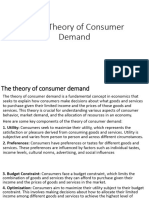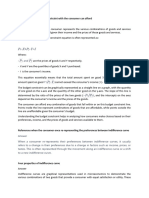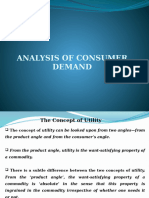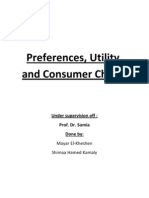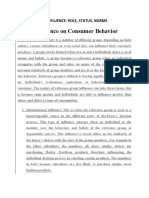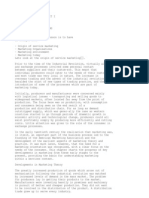Consumer Behavior Analysis: Ordinal Utility Approach: Meaning of Indifference Curve
Consumer Behavior Analysis: Ordinal Utility Approach: Meaning of Indifference Curve
Uploaded by
Yashika MadanCopyright:
Available Formats
Consumer Behavior Analysis: Ordinal Utility Approach: Meaning of Indifference Curve
Consumer Behavior Analysis: Ordinal Utility Approach: Meaning of Indifference Curve
Uploaded by
Yashika MadanOriginal Title
Copyright
Available Formats
Share this document
Did you find this document useful?
Is this content inappropriate?
Copyright:
Available Formats
Consumer Behavior Analysis: Ordinal Utility Approach: Meaning of Indifference Curve
Consumer Behavior Analysis: Ordinal Utility Approach: Meaning of Indifference Curve
Uploaded by
Yashika MadanCopyright:
Available Formats
Consumer Behavior Analysis: Ordinal Utility Approach
Modern economists, particularly Hicks gave ordinal utility concept to analyze consumer
behavior.
He has used the tools, called indifference curve and Budget Line, for consumer behavior analysis.
Assumptions:
i. Rationality: Implies that a consumer is a rational being and aims at maximizing the total
satisfaction given the income and prices of goods and services.
ii. Ordinal Utility: Assumes that utility is expressible only in ordinal terms. This implies that a
consumer is only able to express his/her preference for goods.
iii. Transitivity and Consistency of Choice: Implies that consumer choices are assumed to be
transitive and consistent. The transitivity of choice means that if a consumer prefers A to B and B
to C, he/she would prefer A to C. On the other hand, the consistency of choice means that if a
consumer prefers A to B in one period, he or she cannot prefer B to A in another period.
iv. Non-satiety: Implies that a consumer is assumed to be non-satisfied. In other words, it is
assumed that consumer does not reach the level of satisfaction by consuming a good and always
prefers a large quantity of goods.
v. Diminishing Marginal Rate of Substitution: Acts as an important concept in indifference
curve analysis. Marginal rate of substitution implies the rate at which a consumer is willing to
substitute one good (X) for another good (Y), so that the total satisfaction remains the same.
Meaning of Indifference Curve:
Indifference curve is defined as the locus of points on the graph each representing a different
combination of two substitute goods, which yield the same utility or level of satisfaction to a
consumer. The combinations of goods give equal satisfaction to a consumer.
Therefore, a consumer is indifferent between any two combinations of two goods when it comes
to making a choice between them. When these combinations are plotted on the graph, the
resulting curve is called indifference curve. This curve is also called as iso-utility curve or equal
utility curve.
Marginal Rate of Substitution:
An indifference curve is formed when one good is substituted for other. Marginal Rate of
Substitution (MRS) refers to a rate at which one good is substituted for other, while keeping the
level of satisfaction of a consumer constant. In other words, MRS between two goods X and Y is
defined as the quantity of X which is required to replace Y or quantity of Y required to replace X,
so that the total utility remains same.
You might also like
- A Study On Consumer Buying BehaviourDocument66 pagesA Study On Consumer Buying BehaviourharshNo ratings yet
- Grade 11 Economics Entrance NoteDocument22 pagesGrade 11 Economics Entrance Notebonadeleleng12No ratings yet
- 11 Economic Cours 3&4Document41 pages11 Economic Cours 3&4tegegn mehademNo ratings yet
- Applied Economics Unit-2 Theory of Consumer Demand 6LhrDocument47 pagesApplied Economics Unit-2 Theory of Consumer Demand 6Lhrsusanttiwari2048No ratings yet
- Economics Project 3rd SemesterDocument17 pagesEconomics Project 3rd SemestersahilNo ratings yet
- Ordinal Utility Analysis Learning Objective:: Lecture-6Document6 pagesOrdinal Utility Analysis Learning Objective:: Lecture-6RohitPatialNo ratings yet
- Theory of Consumer ChoiceDocument9 pagesTheory of Consumer ChoiceAbhijit SarkarNo ratings yet
- Utility_newDocument49 pagesUtility_newutkarshumangkotaNo ratings yet
- Utility Note 2Document17 pagesUtility Note 2tamalbanikcuNo ratings yet
- Indifference Curve Analysis in Consumer BehaviorDocument2 pagesIndifference Curve Analysis in Consumer Behaviorkhushal20600k.sNo ratings yet
- Indifference Curve EditedDocument18 pagesIndifference Curve Editedameeshapanwar1No ratings yet
- Lecture-5 - Ordinal ApproachDocument10 pagesLecture-5 - Ordinal Approachrimapatra144No ratings yet
- The Ordinal Approach To Utility AnalysisDocument26 pagesThe Ordinal Approach To Utility AnalysisAurongo NasirNo ratings yet
- Study Material 1 Module - 7 Economics Honours Semester - I CC 1-1 2019-20Document18 pagesStudy Material 1 Module - 7 Economics Honours Semester - I CC 1-1 2019-20BadalNo ratings yet
- Group_6_BasicMicroDocument5 pagesGroup_6_BasicMicroliquiran.levi27No ratings yet
- Consumer TheoryDocument15 pagesConsumer TheoryEdwince OchiengNo ratings yet
- Indifference Curve PDFDocument2 pagesIndifference Curve PDFsrinath asNo ratings yet
- Indifference CurveDocument21 pagesIndifference CurveJaya KohliNo ratings yet
- Eco Project Types of Utility AnalysisDocument2 pagesEco Project Types of Utility Analysisadrianajuthomas1994No ratings yet
- THEORY OF CONSUMER BEHAVIOUR RevisedDocument20 pagesTHEORY OF CONSUMER BEHAVIOUR Revisedbizz3865No ratings yet
- Consumer Behavior Approaches Consumer EquilibriumDocument44 pagesConsumer Behavior Approaches Consumer EquilibriumNanda Kumar100% (2)
- Distinguish Between Cardinal and Ordinal Approach To Explain The ConsumerDocument10 pagesDistinguish Between Cardinal and Ordinal Approach To Explain The ConsumerPoonam ThapaNo ratings yet
- Economics For Business Decisions: Consumer Behaviour, Demand and Supply Module-2Document109 pagesEconomics For Business Decisions: Consumer Behaviour, Demand and Supply Module-2Tushar SahuNo ratings yet
- Consumer's EquilibriumDocument37 pagesConsumer's EquilibriumSoumendra Roy67% (3)
- Grade 11 Economics Module 1Document28 pagesGrade 11 Economics Module 1Ashenafi Legese SegniNo ratings yet
- Utility AnalysisDocument18 pagesUtility Analysisaaku2911becoolandsimpleNo ratings yet
- Abubakar Tafawa Balewa University Bauchi, Bauchi StateDocument11 pagesAbubakar Tafawa Balewa University Bauchi, Bauchi StateeavyjrNo ratings yet
- Unit 3: Theory of Consumer Behavior 3.1Document8 pagesUnit 3: Theory of Consumer Behavior 3.1esman3rdNo ratings yet
- 4th Weekly PPT ME Lecture 28nd Aug-7th September, 2024Document29 pages4th Weekly PPT ME Lecture 28nd Aug-7th September, 2024arvindrai.011974No ratings yet
- Indifference CurveDocument10 pagesIndifference Curvekunj madanNo ratings yet
- Consumer BehaviorDocument7 pagesConsumer BehaviorWondimu Mekonnen ShibruNo ratings yet
- Foe - Unit IiDocument28 pagesFoe - Unit IiKeerthi PriyadarshiniNo ratings yet
- Consumer Preferences and ChoiceDocument22 pagesConsumer Preferences and ChoiceDrGarima Nitin SharmaNo ratings yet
- Microeconomics Chapter 3Document5 pagesMicroeconomics Chapter 3Alejandra jpNo ratings yet
- Utility and Consumers EquilibriumDocument23 pagesUtility and Consumers EquilibriumMaria Eapen0% (1)
- Chap 1 - Consumer Behaviour - FSEG - UDsDocument9 pagesChap 1 - Consumer Behaviour - FSEG - UDsYann Etienne UlrichNo ratings yet
- Properties of Indifferent CurveDocument15 pagesProperties of Indifferent CurvePinkuProtimGogoiNo ratings yet
- Indifference Curve Theory Notes 2022Document16 pagesIndifference Curve Theory Notes 2022derivlimitedsvgNo ratings yet
- Theory of Consumer BehaviorDocument7 pagesTheory of Consumer BehaviorJoyce Anne GarduqueNo ratings yet
- The Theory of Consumer Behaviour: Property 1: Completeness. If An Individual Can Rank Any Pair of BundlesDocument27 pagesThe Theory of Consumer Behaviour: Property 1: Completeness. If An Individual Can Rank Any Pair of BundlesprabodhNo ratings yet
- UNIT-II - Ordinal ApproachDocument27 pagesUNIT-II - Ordinal ApproachSuhani100% (1)
- Unit 3 Grade 11Document38 pagesUnit 3 Grade 11Breket WonberaNo ratings yet
- What is Indifference Curve Explain the Properties ..Document1 pageWhat is Indifference Curve Explain the Properties ..Jhalak SinghNo ratings yet
- Chapter 5 - Consumer TheoryDocument61 pagesChapter 5 - Consumer TheorySsentongo NazilNo ratings yet
- Indifference Curve AnalysisDocument14 pagesIndifference Curve AnalysisRiya Das RdNo ratings yet
- unit2notesDocument23 pagesunit2notespratikfake08No ratings yet
- The Consumer Theory-How They Make The ChoiceDocument42 pagesThe Consumer Theory-How They Make The ChoicePreetham Prinson D'souzaNo ratings yet
- Q.1. What Are Indifference Curves? Explain The Consumers' Equilibrium Under The Assumptions of Ordinal Approach. AnsDocument1 pageQ.1. What Are Indifference Curves? Explain The Consumers' Equilibrium Under The Assumptions of Ordinal Approach. Ansshreekumar_scdlNo ratings yet
- Theory of Consumer BehaviourDocument26 pagesTheory of Consumer BehaviourBikram SaikiaNo ratings yet
- Eco Indifference CurveDocument3 pagesEco Indifference CurveRONSHA ROYS ANNANo ratings yet
- Indifference Curve Analysis PDFDocument24 pagesIndifference Curve Analysis PDFArpita BanerjeeNo ratings yet
- Consumer BehaviorDocument3 pagesConsumer BehaviorShakeel AbbasiNo ratings yet
- Dr. SomayaDocument6 pagesDr. SomayaShimaa H. KamalyNo ratings yet
- Indifference CurveDocument3 pagesIndifference CurveSiva WindriyaniNo ratings yet
- Module4 ConsumerChoiceTheoryDocument32 pagesModule4 ConsumerChoiceTheoryArin GuptaNo ratings yet
- Chapter 2 Theory of Consumer BehaviourDocument10 pagesChapter 2 Theory of Consumer Behavioursujeetbth362No ratings yet
- AdellaDocument3 pagesAdellaNisiima AdellaNo ratings yet
- Indifference CurveDocument14 pagesIndifference Curverajeevbhandari82@gmail.comNo ratings yet
- Theory of Consumer BehaviourDocument31 pagesTheory of Consumer Behaviouryohannestesfaye064No ratings yet
- Eric Stevanus - 2201756600 - LA28Document4 pagesEric Stevanus - 2201756600 - LA28eric stevanusNo ratings yet
- End Term Examination: DEC.2014 - JAN.2015 ToDocument1 pageEnd Term Examination: DEC.2014 - JAN.2015 ToYashika MadanNo ratings yet
- Computer Types and Computer GenerationsDocument21 pagesComputer Types and Computer GenerationsYashika MadanNo ratings yet
- Booting of A Computer SystemDocument9 pagesBooting of A Computer SystemYashika MadanNo ratings yet
- Input & Output DevicesDocument21 pagesInput & Output DevicesYashika MadanNo ratings yet
- About Ms PowerptDocument1 pageAbout Ms PowerptYashika MadanNo ratings yet
- MSWORD Shortcut KeysDocument7 pagesMSWORD Shortcut KeysYashika MadanNo ratings yet
- What Is Leadership?: Leading People Influencing People Commanding People Guiding PeopleDocument18 pagesWhat Is Leadership?: Leading People Influencing People Commanding People Guiding PeopleYashika MadanNo ratings yet
- Introduction To Indian Legal SystemDocument11 pagesIntroduction To Indian Legal SystemYashika MadanNo ratings yet
- List of TablesDocument4 pagesList of Tablest6ygtvgvNo ratings yet
- Group Influence On Consumer BehaviorDocument23 pagesGroup Influence On Consumer BehaviorAnilBahugunaNo ratings yet
- Sharma 1Document76 pagesSharma 1Sahib RandhawaNo ratings yet
- Consumer Behaviour Models in Hospitality and TourismDocument16 pagesConsumer Behaviour Models in Hospitality and Tourismfelize padllaNo ratings yet
- Does The Purchase Intention of Green Consumers Align With TheirDocument15 pagesDoes The Purchase Intention of Green Consumers Align With TheirNguyễn Thành ChiếnNo ratings yet
- Microeconomics CH 2ADocument5 pagesMicroeconomics CH 2Adeepak.5718.7bNo ratings yet
- "A Study On Sales and Marketing Strategy of Hero Motocorp": Summer Training Report OnDocument91 pages"A Study On Sales and Marketing Strategy of Hero Motocorp": Summer Training Report Onravi singhNo ratings yet
- Big Data Relevance Retailers 0714 1 PDFDocument14 pagesBig Data Relevance Retailers 0714 1 PDFSai KuNo ratings yet
- Principles of Marketing 2022 Question PaperDocument2 pagesPrinciples of Marketing 2022 Question PaperJibangkur Baishya100% (1)
- Access Consumer Behavior 12th Edition Schiffman Test Bank All Chapters Immediate PDF DownloadDocument55 pagesAccess Consumer Behavior 12th Edition Schiffman Test Bank All Chapters Immediate PDF Downloadmcghandorle100% (4)
- Project Report On "FACTORS AFFECTING BRAND CHOICE OF MOBILE PHONE HANDSETS"Document66 pagesProject Report On "FACTORS AFFECTING BRAND CHOICE OF MOBILE PHONE HANDSETS"Amit DhankharNo ratings yet
- Roots 5Document12 pagesRoots 5sec22mb178No ratings yet
- Consumer Behavior Towards Online Delivery Firms Offering Food - PPT For Final DefenseDocument23 pagesConsumer Behavior Towards Online Delivery Firms Offering Food - PPT For Final DefensePaul MonataNo ratings yet
- Business Buying BehaviourDocument19 pagesBusiness Buying BehaviourRohit TripathiNo ratings yet
- CB - Module1 - Notes by Vivek SirDocument18 pagesCB - Module1 - Notes by Vivek SirDeepak Kumar DebdasNo ratings yet
- Devbhog Internship Project PDFDocument60 pagesDevbhog Internship Project PDFJayant67% (3)
- IGNOU MBA SyllabusDocument38 pagesIGNOU MBA SyllabusRavikantSinghNo ratings yet
- Chapter Five: Consumer Markets and Consumer Buyer BehaviorDocument18 pagesChapter Five: Consumer Markets and Consumer Buyer Behaviormohamed ibrahimNo ratings yet
- 2 Part The Brand Positioning of L&TDocument33 pages2 Part The Brand Positioning of L&TAJESHNo ratings yet
- Chapter 1 4 Final 101924Document113 pagesChapter 1 4 Final 101924ysabelatondo03No ratings yet
- PG1 21 - 6 - Maybelline LLC - Fit Me Maybelline New York Matte Poreless FoundationDocument12 pagesPG1 21 - 6 - Maybelline LLC - Fit Me Maybelline New York Matte Poreless Foundationpink pinkNo ratings yet
- Research Paper On Consumer Behaviour Towards Eco-Friendly ProductsDocument12 pagesResearch Paper On Consumer Behaviour Towards Eco-Friendly ProductsJagritiChhabra100% (1)
- You Make Better Decisions If YouDocument4 pagesYou Make Better Decisions If YouFaaiz ButtNo ratings yet
- 02 Tarn European Economics LettersDocument10 pages02 Tarn European Economics LettersLizethNo ratings yet
- Topic - ELASTICITY OF DEMAND PDFDocument19 pagesTopic - ELASTICITY OF DEMAND PDFShilpaNo ratings yet
- Desain Produk Dan Harga JurnalDocument8 pagesDesain Produk Dan Harga JurnalcahayaabadicemerlangcacNo ratings yet
- Manvendra Singh Project Final 2024 31Document75 pagesManvendra Singh Project Final 2024 319648781773ashiNo ratings yet
- ServicesmarketingnotesDocument387 pagesServicesmarketingnotesBhuvi SenthilNo ratings yet
- The Effect of Gender On Consumer BehaviourDocument8 pagesThe Effect of Gender On Consumer BehaviourJASPREET SAININo ratings yet



